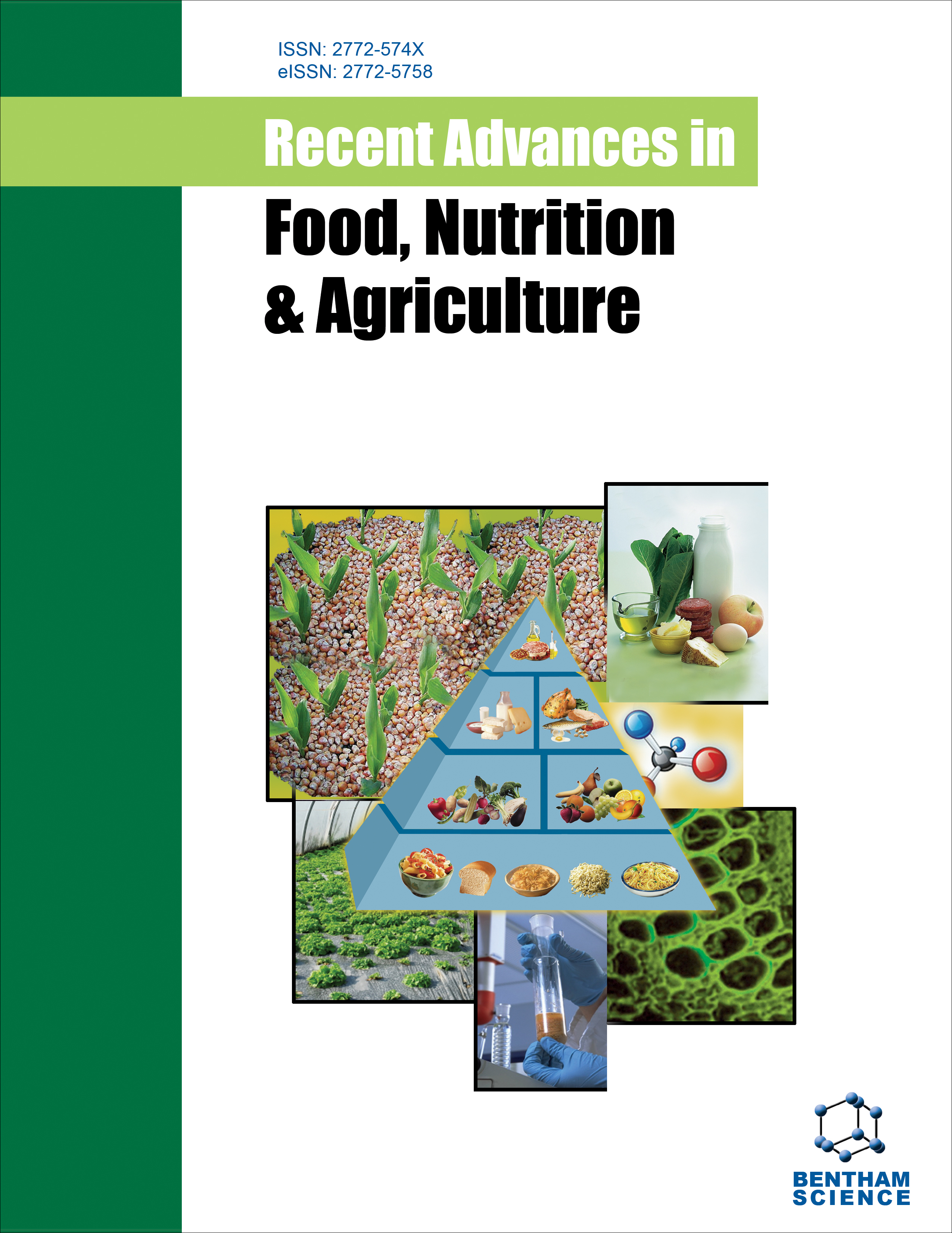- Home
- A-Z Publications
- Recent Advances in Food Nutrition & Agriculture
- Previous Issues
- Volume 13, Issue 2, 2022
Recent Advances in Food Nutrition & Agriculture - Volume 13, Issue 2, 2022
Volume 13, Issue 2, 2022
-
-
Sustainable Approaches to Boost Yield and Chemical Constituents of Aromatic and Medicinal Plants by Application of Biostimulants
More LessAuthors: Mohamad H. Shahrajabian and Wenli SunIntroduction: Biostimulants consist of natural ingredients, metabolites of fermentation, micro-organisms, algae or plant extracts, bacteria, mushrooms, humus substances, amino acids, biomolecules, etc. Methods: In this study, all relevant English-language articles were collected. The literature was reviewed using the keywords of biostimulant, medicinal plant, aromatic plant, natural products, and pharmaceutical benefits from Google Scholar, Scopus, and PubMed databases. Results: The significant and promoting impact of biostimulants has been reported for different medicinal and aromatic plants, such as salicylic acid for ajuga, artichoke, ajwain, basil, common rue, common sage, common thyme, coneflower, coriander, dendrobium, desert Indian wheat, dragonhead, fennel, fenugreek, feverfew, ginger, groundnut, guava, henna, Iranian soda, lavender, lemon balm, lemongrass, Malabar spinach; seaweed extract on almond, bird,s eye chili; amino acids on artemisia, broccoli, chamomile, beneficial bacteria on ashwagandha; humic acid on black cumin, cannabis, chicory, garlic, gerbera, Hungarian vetch, Moldavian dragonhead, niger plant; chitosan on dragon fruit, marigold, milk thistle, etc. The suggested mechanisms include the stimulatory impacts on the activity of enzymes involved in different biosynthetic processes, the hormone-like activity of biostimulant compounds and the improvement of nutrient uptake of plants. Conclusion: The current manuscript gives many examples of the potential of biostimulants for medicinal and aromatic plant production. However, further studies are needed to better understand the effectiveness of different biostimulants and foliar applications in sustainable agriculture.
-
-
-
Locust Bean Gum: Processing, Properties and Food Applications
More LessAuthors: Arun K. Singh, Rishabha Malviya and Gudhanti Siva Naga Koteswara RaoLocust bean gum is derived from the seed endosperm of the Ceratonia siliqua carob tree and is known as locust bean or carob gum. Food, medicines, paper, textile, oil drilling, and cosmetic sectors all use it as an ingredient. Hydrogen bonding with water molecules makes locust bean gum useful in industrial settings. In addition, its dietary fibre activity helps regulate numerous health issues, including diabetes, bowel motions, heart disease and colon cancer. Locust bean gum production, processing, composition, characteristics, culinary applications, and health advantages are the subject of this article.
-
-
-
Punica granatum Peel Waste - An Underutilized Substrate of Therapeutic Potential: An Overview
More LessAuthors: Uroosa Noor, Shashi Soni and Ena GuptaIndia is the second largest consumer and producer of fruits globally. It leads to ample solid waste per year from fruit processing industries that have been proven hazardous to the surroundings. Punica granatum (Pomegranate) belongs to the Lythraceae subfamily Punicoideae, which exhibits immense nutritional properties and delicious flavoring components. The weight of this fruit mainly consists of peel, i.e., 50%, followed by 40% of arils and 10% of seeds. Thus, the major byproduct is peel that holds many valuable bioactive compounds in higher concentrations viz saponins, carotenoids, steroids, polyphenols, quercetin derivatives, caffeic acid, phenolic acids, flavonoids, ellagitannins, p-coumaric acid, chlorogenic acid, quinic acid, anthocyanidins, triterpenoids, glycosides, tannins, and many more. Consequently, it results in wideranging therapeutic applications, including antioxidative, anti-microbial, antihypertensive, anticarcinogenic, anti-genotoxic, anti-inflammatory, glucoregulation, cardio-protective, hepatoprotective and nephroprotective effects along with prebiotic potential. Considering their nutritional and therapeutic aspects, these peels can be used for many purposes rather than being disposed off. With a value-added approach, it is utilized in many food and non-food sectors. So, this review aims to explore the therapeutic potential of P. granatum peel and enlighten its diverse applications in the food industry.
-
-
-
Study the Pharmacognostic Profile, Antiradical and Hepatoprotective Potential of Carissa carandas Linn. Fruit Extract
More LessAuthors: Sonia Singh and Nitin AgarwalAims: Carissa carandas Linn. is a thorny shrub (Family: Apocynaceae), commonly called Karonda. The shrub can be grown in tropical and subtropical climate regions. Methods and Materials: The objective of the experimental work was to analyze the efficacy of fruit extract of C. carandas Linn. with respect to the hepatoprotective property using supportive evidence of in vitro and in vivo antiradical activity. The antioxidant activity of ethanolic fruit extract was determined by 2, 2-diphenyl-1-picrylhydrazyl (DPPH), hydrogen peroxide and nitric oxide free radical scavenging assay, using Ascorbic acid as a standard drug. Oral administration of C. carandas Linn. ethanolic fruit extract (200 and 400 mg/kg) revealed a considerable marked protection property against acute hepatotoxicity induced by the carbon tetrachloride, moreover, that has been evaluated in terms of biochemical parameters. Results: Administration of carbon tetrachloride (CCl4) induce amplified levels of serum biomarker enzymes including alanine aminotransferase (ALT), aspartate transaminase (AST) and alkaline phosphatase (ALP) in the blood serum with attenuated in-vivo antioxidant enzymes levels such as superoxide dismutase (SOD), reduced glutathione (GSH) and catalase in hepatic tissues. The administration of fruit extract would reduce the CCl4- induced hepatic toxicity; these effects may be due to the presence of phytochemicals including carbohydrates, tannins, phenolic components and flavonoids. However, HPLC and TLC studies would ensure the presence of gallic and quercetin in the ethanolic fruit extract of the plant. Conclusion: The ethanolic fruit extract of C. carandas Linn. exhibits significant hepatoprotective activity which could be partly imputed to its both in-vitro as well as in-vivo antioxidant property, together with effective total phenolic and total flavonoid content and thus concedes for further findings.
-
Volumes & issues
Most Read This Month

Most Cited Most Cited RSS feed
-
-
Drug-food Interactions in the Era of Molecular Big Data, Machine Intelligence, and Personalized Health
Authors: Romy Roy, Shamsudheen Marakkar, Munawar P. Vayalil, Alisha Shahanaz, Athira Panicker Anil, Shameer Kunnathpeedikayil, Ishaan Rawal, Kavya Shetty, Zahrah Shameer, Saraswathi Sathees, Adarsh Pooradan Prasannakumar, Oommen Kaleeckal Mathew, Lakshminarayanan Subramanian, Khader Shameer and Kamlesh K. Yadav
-
- More Less

